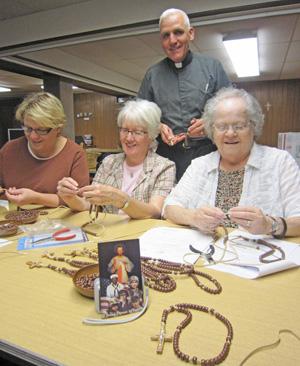
By Father Bill Kneemiller
Isaiah 2:2 references “swords being turned into plowshares and spears into pruning hooks.” I thought of this Scripture as I ordered another 1,000 feet of parachute cord, enough to make about 300 Holy Land Military rosaries.
This rosary is actually made from standard parachute cord, with 9 mm brown pony beads and completed with a hand-crafted olive wood cross with metal corpus that is made in the Holy Land. This rosary is one of the most effective sacramentals I have ever seen.
The story of the Holy Land Rosary dates back to spring 2010. I was in Afghanistan with my Cedar Rapids Reserve unit, just months away from completing a year’s deployment. I knew there was one more project to work on: providing soldiers with a rosary made with a hand-crafted olive wood crucifix.
I emailed Julie Walton at Maryland-based Ranger Rosary Inc. and asked if she could help me in the design and purchase of olive wood crucifixes to be used with brown beads and the parachute cord of the Ranger Rosaries. The Ranger Rosary kits come with a plastic crucifix, but I wanted an olive wood crucifix. Julie agreed and thus was born the Holy Land Military Rosary.
I owe recognition to Ranger Rosary Inc. for the inspiration. The Ranger Rosary concept came from “route counting” beads that the Army still uses. The “route counter” is a string of about 20 beads on a parachute cord attached to one’s uniform. Each bead is used to count 10 meters, and is useful in cross-country land navigation.
A staff sergeant using this route counter in 1981 thought it reminded him of a rosary. He added the “Our Father” beads and a few more decades to make the first Ranger Rosary. Years later, when his children learned to make rosaries at a Jr. Legion of Mary meeting, he and his family and other families began making the Ranger Rosary and distributed them in Bosnia in the late 1990s. Word spread and demand grew. St. Mary Parish in Annapolis, Md., was recruited for assistance. The rosary-making project has grown to 25 participating parishes, which have made more than 500,000 Ranger Rosaries for U.S. soldiers stationed around the world, according to www.rangerrosary.com. Ranger Rosary continues as the premier rosary supplier to U.S. soldiers world-wide.
In the past year I have helped several Iowa parishes to start making Holy Land Military rosaries. The cost is about $2.40 each, most of which pays for the olive wood crucifix. However, the funds spent on the crucifix go for a good cause as they directly support the Catholic Christian wood carvers living in the Holy Land.
At St. Joseph Parish in Hills, our rosary-making groups have a goal to send 75 percent of the Holy Land Military rosaries overseas to soldiers and the rest to families, especially young people, to promote the rosary and pray for the safety of soldiers and for peace.
Kay Evans organizes the rosary-making group, which meet the third Sunday of each month after 10:15 a.m. Mass. A rosary-making training session on Sept. 15 will meet from 6:30-8 p.m. at St. Joseph’s. Kay says, “Making these rosaries makes me feel closer to our Lord and his mother. And with a wee bit of instruction, they come out ‘nearly perfect.’”
To order your own rosary-making supplies, send a stamped, self-addressed envelope to Fr. Kneemiller, PO Box 187, Hills, IA 52256. I’ll send you instructions and the vendors for the cord, beads and the U.S. representative for the Holy Land crosses.
Soldiers love this rosary. Kids like it, and it is especially helpful for middle school and high school boys who need to see the rosary being a little more “hoo-ah” (the Army lingo that loosely translates as “YEAH”).
I witnessed a prisoner in the state prison hold the olive wood crucifix in his hands and then immediately ask to go to reconciliation after 15 years of being away from the sacrament. I have had several terminal cancer patients ask to have this rosary. The next time I saw the rosary, it was in their hands in the casket in the funeral home.
I believe that the power of this rosary comes from the symbol of the olive wood cross. Christ prayed in agony in the Garden of Olives and the olive wood used for the crucifix is generally taken from trees in the area of Bethlehem. In 1 Cor. 2, Paul wrote that he was “determined not to preach anything, save Jesus Christ and him crucified.”
The cross is a symbol of Christ’s power, grace, love and salvation. As I use this rosary for prayer, I experience the olive wood cross as a sacramental aid connecting me to Christ’s passion in the garden, along with the prayers and scriptural mediations of the rosary. This is why I call it the “nearly perfect rosary.”
(Father Bill Kneemiller is pastor of St. Joseph Parish in Hills and St. Mary parishes in Lone Tree and Nichols.)









ware can i get the crusifixs for the rosaries i need 40 of thim
I am very interested in making these Rosarys. I make mission Rosarys and wonder if
These are made the same way? Where do you get your beads and crosses? I am
Interested in a good olive wood beads supplier(from the Holy Land).
Who would have thought, pony beads and parachute cord!!!
Thank you for your assistance and dedication. Tina. My brother and nephew were in
Afghanistan. Three of my nephews buddies perished in a humvie bombing, Daniel was
The sole survivor! Please pray for his healings. Thank you.
Great job on the web site. Your doing a terrific job!!!!